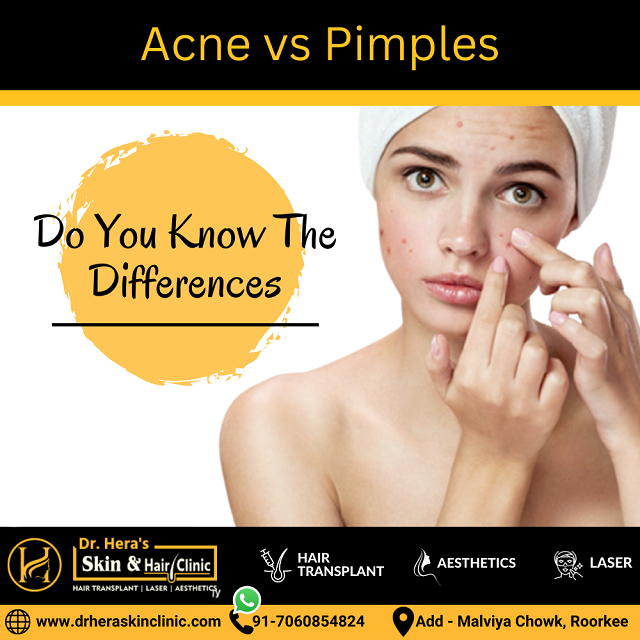Oh no, a new zit has appeared on my forehead.
Is it a pimple? Acne? Pimple?
Contrary to popular belief, the terms “zit,” “acne,” and “pimples” are not interchangeable. There are various types of acne, as any licenced dermatologist would attest, and various acne treatments are available in Roorkee.
1) Grade 1: Blackheads or whiteheads, also known as comedones in medicine
2) Grade 2 boils, also known as pimples at this stage, are either reddish or not painful.
3) Grade 3 boils, also known as pimples at this stage, are painful, pus-filled boils.
4) Grade 4: Larger nodules that resemble cysts

How Does Acne Form on Skin?
The pores on human skin connect to the sebaceous glands, also called “oil glands.” These glands connect to the hair follicle and emerge onto the skin through it. Acne issues arise when these follicles and pores become clogged due to dead skin cells and sebum buildup. Inflaming and bacteria bring on reddening of the skin in blocked skin pores.
If acne is a skin condition, then pimples are considered to be its symptoms. Pimples are red, pus-filled lesions that develop when oil-clogged pores burst. In the ruptured pores, bacteria grow, leading to more complications.
Types Of Acne Vs Types Of Pimples
Acne issues can be categorised into various subtypes based on their nature, appearance, and pain level. Blackheads and whiteheads, also known as “closed comedones,” are relatively common and less severe forms of acne. Blackheads develop when the underlying plugs that clog skin pores become oxidised from exposure to the outside environment. Acne types known as “nodules” and “cysts” are complex and typically uncomfortable.
On the other hand, papules and pustules are the two main classifications of pimples. The former category consists of relatively small, unproblematic pimples. It is manageable to treat. The type of pimple heavily swollen and filled with pus is called a pustule. Consulting a reputable dermatologist is highly advised to treat these.
Reasons for acne
Some people’s skin is prone to acne, while others are not. However, acne outbreaks are typically brought on by excessive production of sebum. Acne flare-ups can be brought on by a variety of factors, including hormonal imbalances (puberty, pregnancy, or irregular menstrual cycles, for example), bacterial infections, corticosteroid and anabolic steroid side effects, exposure to high humidity, having unhealthy or irregular diet, and frequently using oil-based cosmetics and makeup.
Most of the underlying factors for acne and pimples are similar. Too much sebum, genetic problems, and other factors can clog pores with dirt, hair, and bacteria. Understanding the true cause of acne and pimple attacks and using the appropriate skincare routine and treatment methods are key.
The Different Types Of Acne
It is important to comprehend the various grades of acne before moving on to the treatment procedures for various types of acne and pimples. When acne is present, but there are no boils, it is said to be in grade I.
Acne in grade II is when zits first appear. These may appear reddish or pink and be painfully inflamed. Along with the previously mentioned factors, acne problems can also be brought on by less-than-optimal sleep, frequent junk food consumption, or even a waxing or threading session.
As the pus in the pimples builds up, grade III acne rears its ugly head. At this stage, secondary infections are also possible. Dermatologists frequently advise using retinol, benzoyl peroxide, dapsone, and adapalene in treatment regimens. Nevertheless, clindamycin should not be used indiscriminately as it can have negative effects.
Pimple & Acne Treatment Tips
Many people err by ignoring chronic acne issues or dismissing them as “just an age-related thing that will go away on its own.” Acne and pimples can leave permanent scars and skin blemishes on the body. To solve the issue, it is crucial to seek medical attention.
Consult A Dermatologist Expert
It is not advisable to use OTC products containing salicylic acid, retinoids, benzoyl peroxide, and other related ingredients without consulting a skin specialist. A dermatologist can suggest laser procedures, chemical peels, cryotherapy, and other cutting-edge acne/acne scar treatment options in addition to typical medications and antibiotics.
Understanding the distinctions between acne and pimples is crucial to determining the kind of skin care needed to treat the issues effectively. You should also be aware that not all reddish bumps on the face are acne. For instance, “acne rosacea,” a condition that makes the blood vessels on the face visible, is not a form of acne. Other skin conditions include “gram-negative folliculitis” and “sycosis barbae.” Acne and pimples, in particular, as well as other skin conditions, can be extremely upsetting and seriously undermine someone’s self-confidence. To experience long-lasting relief from these annoying skin conditions, getting in touch with a reputable skin care facility is essential.
